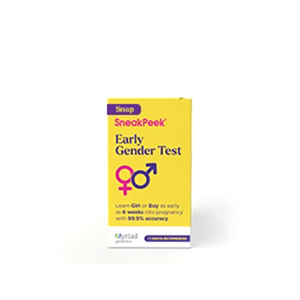Published on October 26th, 2020 and Updated on January 12th, 2024
Check out SneakPeek Gender Test to find out your baby’s gender as early as 6 weeks at over 99% accuracy1!
Before modern science, ancient myths and old wives’ tales seemed to have all the answers when it came to understanding freckles. Since then, however, researchers have discovered scientific explanations for freckles, helping to explain everything from where do freckles come from to why babies don’t have them.
If you’ve ever wondered, when do babies get freckles and how do freckles form, keep reading further. In this article, we’ll dive into the science and research behind freckles so that you can better understand whether they’ll make an appearance on your baby.
What are freckles?
Freckles are small, flat, and pigmented spots that can develop anywhere on your skin. Typically, they’re found on sun-exposed areas of the body, appearing in colors like:
- Tan
- Light beige
- Dark brown
- Red
Freckles are extremely common and are not a health threat (unlike some other skin marks). They can also be permanent or temporary, depending on how they developed.
This begs the question, how and why do freckles form?
There are two types of freckles, and each type forms in a different way:
- Ephelides – These flat dots are a result of sun exposure, appearing red or tan-brown on the skin. They usually develop on exposed areas like the face, arms, or chest. Ephelides can appear in toddlerhood all the way into old age, although they’re often temporary, fading with time.
- Solar lentigines – A more permanent form of freckle, solar or actinic lentigines are colored patches of skin. These patches can appear yellow, red, tan, or dark brown. Solar lentigines are the result of repeated sun exposure, usually developing in adults over 40 years old.
When babies or young children develop freckles, they’re usually ephelides. Solar lentigines require years of sun exposure to form, so it’s safe to say your child won’t develop solar lentigines just yet.
Are freckles genetic?
A child’s likelihood for inheriting freckles depends on two factors:
- Sun exposure time and intensity
- Genetic predisposition
This means that if your child has a genetic predisposition to freckles, they’ll likely appear at some point during his life.
Children with less melanin have a greater genetic predisposition for freckles. Melanin is a family of naturally-occurring pigments that all bodies produce in different amounts. The more melanin you produce, the more pigmented your skin, hair, and eyes may appear.
In particular, these physical traits overlap with lower melanin production:
- Fair skin (typically those of white or Asian ethnicity)
- Blonde hair
- Red hair
- Light-colored eyes (green, blue, gray, etc.)
Besides your body’s natural production, melanin is also triggered by the sun’s UV rays. If you’re born with less melanin, then your skin will react to sunlight by producing concentrated amounts of it—leading to freckles. On the other hand, children born with higher melanin usually tan in response to sun exposure.
Why don’t babies have freckles when they’re born?
If freckles and skin pigmentation are genetic, it makes sense to ask the question, can you be born with freckles? However, the reason why babies don’t have freckles when they’re born is because of their lack of sun exposure.
As stated earlier, the sun is a prerequisite for freckles. Since babies don’t see the sun until after they enter the world, freckles can’t develop on your baby’s skin until after birth.
When do freckles appear on a child?
If babies aren’t born with freckles, how long will it be before their freckles appear?
Commonly, children with a genetic predisposition for freckles will start to develop freckles around two to four years old. These toddler years just so happen to be when kids spend more time outdoors, leading to more sun exposure, and thus, more freckles.
However, there’s a specific timeline for freckle development. Your child may develop freckles much later in life, or even a little earlier.
The Science Behind Freckles
How exactly does sunlight create freckles? It all comes down to the power of melanocytes.
Melanocytes are skin cells that produce melanin. The distribution of these skin cells determines whether your child will have freckles or not. Depending on genetics, your child’s melanocytes will fall into one of two distribution categories:
- Even distribution – People with a uniform spread of melanocytes across the surface of their skin usually end the summer months in the sun with an even tan. All areas of the skin produce melanin at the same rate, so the exposed skin darkens to the same degree. Even distribution is more common in people of African, South American, or South Asian descent.
- Clumped distribution – People with a clumped or uneven spread of melanocytes usually end a day in the sun with darker spots surrounded by light red (or sunburnt) skin. Clumped melanocytes are the genetic cause for freckles, creating small “pockets” of pigmented skin triggered by sun exposure. Clumped distribution is more common in people of European or Asian descent.
Why would humans have different melanocyte patterns? The latest science believes this is due to human evolution in high-sun vs. low-sun environments.
In high-sun exposure areas (closer to the equator), humans evolved to produce more melanin with even melanocyte distribution. In contrast, humans from low-sun exposure areas (farther from the equator) evolved to produce less melanin with clumped distribution.
Theories for this genetic variation range from producing adequate vitamin D to preventing skin cancer. However, no one theory has emerged as the sole reason behind different melanin levels.
Genes & Mutations – The Start of Freckles
In all humans, the MC1R gene is the particular gene that instructs a protein receptor to produce melanin. However, research shows that mutations in the MC1R gene may tell that receptor to produce different amounts of different melanin types. These types include:
- Pheomelanin – A yellow-red pigment that’s present in red hair, light-colored skin, and freckles.
- Eumelanin – A type of pigment responsible for black and brown hair, darker skin colors, and brown eyes.
- Neuromelanin – A type of pigment that controls the invisible color of your neurons.
When an MC1R mutation produces more pheomelanin than eumelanin, it correlates with freckle-friendly melanocyte distribution and features like light eyes and red hair. A study in Human Molecular Genetics explored this mutation.
The study took the DNA of over 1000 children with freckles who had skin types I to IV on the Fitzpatrick skin type scale (very pale skin to light brown skin that tans easily). The findings? Those with more freckles were more likely to carry mutations in the MC1R gene—about 60% of participants with freckles. However, there’s still no single proven genetic cause behind freckles.
Are there health concerns with having freckles?
Freckles are not a reason to worry – For the most part, freckles are harmless skin pigmentation and nothing more.
On their own, freckles have almost zero chance of becoming cancerous or dangerous. In fact, skin cancer itself is very rare in children, accounting for only 3% of pediatric cancer cases.
However, other pigmented skin marks or your child may be worth your attention, possibly hinting at a melanoma (the mark of skin cancer). If a previously-thought freckle or spot on the skin seems abnormal, consider the ABCDE’s for melanoma from The Skin Cancer Foundation:
- A for Asymmetry – If the pigmented area is irregular and undefined
- B for Borders – If the borders are ridged or nonuniform
- C for Color – If the spot has multiple colors or shades
- D for Diameter – If the spot is bigger than 0.25 inches in diameter
- E for Evolving – If the freckle, mole, or spot changes in shape or size
Moles, or raised pigmented spots on the skin, carry a higher risk of melanoma. However, most are harmless, just like freckles. To be safe, consider giving your child regular skin checks every few months or so in case any new spots appear or any old spots start to change.
This post has been reviewed for accuracy by the following medical professional:
Katie Smith is a seasoned Certified Nurse Midwife and a nurturing mother to six children, offering a unique blend of professional expertise and personal experience. She is the founder of Birth Your Way Midwifery and Women’s Wellness Center in Bay County, Florida. Katie's comprehensive approach to care is informed by her hands-on experience in motherhood and her passion for empowering women through their birthing journey. Her dedication extends beyond her center as she actively engages in community wellness and family health education.
Sources:
- Britannica.
Melanocyte. https://www.britannica.com/science/melanocyte
- Children’s Hospital of Philadelphia.
Skin Cancer in Children. https://www.chop.edu/conditions-diseases/skin-cancer-children
- Cleveland Clinic. Freckles:
What They Are, vs. Moles, Causes & Removal. https://my.clevelandclinic.org/health/articles/23091-freckles
- Cleveland Clinic.
Melanin: What Is It, Types & Benefits. https://my.clevelandclinic.org/health/body/22615-melanin
- Healthline.
Fitzpatrick Skin Types: Which Are You? https://www.healthline.com/health/beauty-skin-care/fitzpatrick-skin-types
- Johns Hopkins All Children’s Hospital.
Why Do Some Kids Have Freckles? https://www.hopkinsallchildrens.org/Patients-Families/Health-Library/HealthDocNew/Why-Do-Some-Kids-Have-Freckle
- NIH.
Understanding the Melanocyte Distribution in Human Epidermis: An Agent-Based Computational Model Approach. https://www.ncbi.nlm.nih.gov/pmc/articles/PMC3392240/
- Penn State University.
The Evolution of Human Skin Color. https://www.psu.edu/impact/story/the-evolution-of-skin-color/
- Skin Cancer Foundation.
Melanoma Warning Signs. https://www.skincancer.org/skin-cancer-information/melanoma/melanoma-warning-signs-and-images/
- Oxford Academic.
Melanocortin-1-receptor gene is the major freckle gene. https://academic.oup.com/hmg/article/10/16/1701/582138

Shop Our Products
SneakPeek aims to provide the most accurate and up-to-date information to help our readers make informed decisions regarding their health before, during, and after pregnancy. This article was written based upon trusted scientific research studies and/or articles. Credible information sources for this article are cited and hyperlinked.






